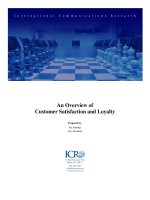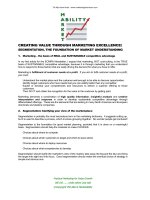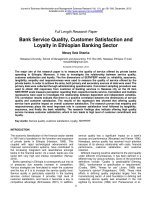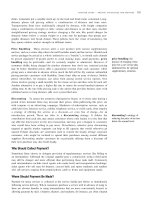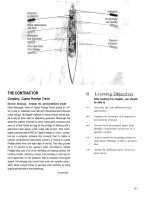Creating Customer Value, Satisfaction, and Loyalty doc
Bạn đang xem bản rút gọn của tài liệu. Xem và tải ngay bản đầy đủ của tài liệu tại đây (252.14 KB, 20 trang )
Creating Customer Value,
Satisfaction,
and Loyalty
Marketing Management, 13
th
ed
5
Copyright © 2009 Pearson Education, Inc. Publishing as Prentice Hall
5-2
Chapter Questions
•
What are customer value, satisfaction, and
loyalty, and how can companies deliver them?
•
What is the lifetime value of customers?
•
How can companies cultivate strong customer
relationships?
•
How can companies both attract and retain
customers?
•
What is database marketing?
Copyright © 2009 Pearson Education, Inc. Publishing as Prentice Hall
5-3
What is Customer Perceived Value?
Customer perceived value is the
difference between the prospective
customer’s evaluation of all the benefits
and all the costs of an offering and the
perceived alternatives.
Copyright © 2009 Pearson Education, Inc. Publishing as Prentice Hall
5-4
Figure 5.2 Determinants of
Customer Perceived Value
Image benefit Psychological cost
Personal benefit Energy cost
Services benefit Time cost
Product benefit Monetary cost
Total customer benefit Total customer cost
Copyright © 2009 Pearson Education, Inc. Publishing as Prentice Hall
5-5
Steps in a Customer Value Analysis
•
Identify major attributes and benefits
that customers value
•
Assess the qualitative importance of
different attributes and benefits
•
Assess the company’s and competitor’s
performances on the different customer
values against rated importance
•
Examine ratings of specific segments
•
Monitor customer values over time
Copyright © 2009 Pearson Education, Inc. Publishing as Prentice Hall
5-6
What is Loyalty?
Loyalty is a deeply held commitment to
re-buy or re-patronize a preferred
product or service in the future despite
situational influences and marketing
efforts having the potential to cause
switching behavior.
Copyright © 2009 Pearson Education, Inc. Publishing as Prentice Hall
5-7
Top Brands in Customer Loyalty
•
Avis
•
•
L.L. Bean
•
Samsung (mobile
phones)
•
Yahoo!
•
Canon (office
copiers)
•
Land’s End
•
Coors
•
Hyatt
•
Marriott
•
Verizon
•
KeySpan Energy
•
Miller Genuine Draft
•
Amazon
Copyright © 2009 Pearson Education, Inc. Publishing as Prentice Hall
5-8
Measuring Satisfaction
•
Periodic surveys
•
Customer loss rate
•
Mystery shoppers
•
Monitor competitive performance
Copyright © 2009 Pearson Education, Inc. Publishing as Prentice Hall
5-9
What is Quality?
Quality is the totality of features and
characteristics of a product or
service that bear on its
ability to satisfy
stated or implied needs.
Copyright © 2009 Pearson Education, Inc. Publishing as Prentice Hall
5-10
Maximizing Customer Lifetime Value
•
Customer profitability
•
Customer equity
•
Lifetime value
Copyright © 2009 Pearson Education, Inc. Publishing as Prentice Hall
5-11
Estimating Lifetime Value
•
Annual customer revenue: $500
•
Average number of loyal years: 20
•
Company profit margin: 10
•
Customer lifetime value: $1000
Copyright © 2009 Pearson Education, Inc. Publishing as Prentice Hall
5-12
What is Customer Relationship
Management?
CRM is the process of carefully
managing detailed information about
individual customers and all customer
touchpoints to maximize
customer loyalty.
Copyright © 2009 Pearson Education, Inc. Publishing as Prentice Hall
5-13
Framework for CRM
•
Identify prospects and customers
•
Differentiate customers by needs and
value to company
•
Interact to improve knowledge
•
Customize for each customer
Copyright © 2009 Pearson Education, Inc. Publishing as Prentice Hall
5-14
CRM Strategies
•
Reduce the rate of defection
•
Increase longevity
•
Enhance share of wallet
•
Terminate low-profit customers
•
Focus more effort on high-profit
customers
Copyright © 2009 Pearson Education, Inc. Publishing as Prentice Hall
5-15
Customer Retention
•
Acquisition of customers can cost 5 times
more than retaining current customers.
•
The average customer loses 10% of its
customers each year.
•
A 5% reduction to the customer defection
rate can increase profits by 25% to 85%.
•
The customer profit rate increases over the
life of a retained customer.
Copyright © 2009 Pearson Education, Inc. Publishing as Prentice Hall
5-16
Steps for Creating
Customer Evangelists
•
Customer plus-delta
•
Napsterize your knowledge
•
Build the buzz
•
Create community
•
Make bite-size chunks
•
Create a cause
Copyright © 2009 Pearson Education, Inc. Publishing as Prentice Hall
5-17
Database Key Concepts
•
Customer
database
•
Database
marketing
•
Mailing list
•
Business
database
•
Data warehouse
•
Data mining
Copyright © 2009 Pearson Education, Inc. Publishing as Prentice Hall
5-18
Using the Database
•
To identify prospects
•
To target offers
•
To deepen loyalty
•
To reactivate customers
•
To avoid mistakes
Copyright © 2009 Pearson Education, Inc. Publishing as Prentice Hall
5-19
Don’t Build a Database When
•
The product is a once-in-a-lifetime
purchase
•
Customers do not show loyalty
•
The unit sale is very small
•
The cost of gathering information is too
high
Copyright © 2009 Pearson Education, Inc. Publishing as Prentice Hall
5-20
Perils of CRM
•
Implementing CRM before creating a
customer strategy
•
Rolling out CRM before changing the
organization to match
•
Assuming more CRM technology is
better
•
Stalking, not wooing, customers


